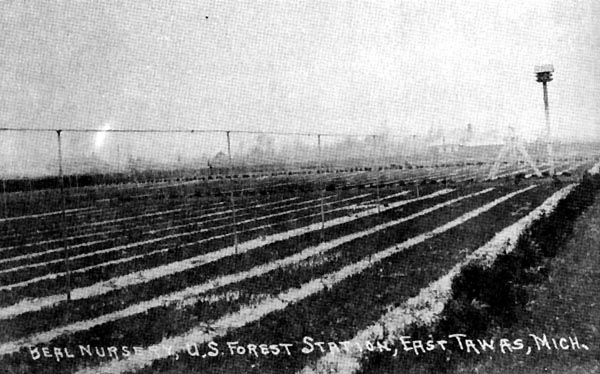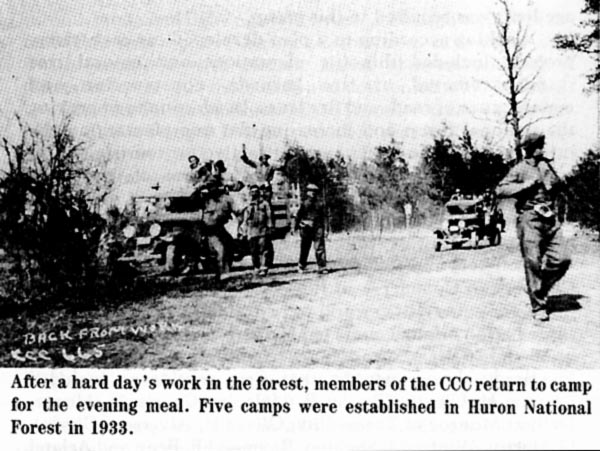Logging and milling had begun in earnest between 1830 and 1840. In general, the pine lands and the central, southern, and eastern areas were logged first and most completely, and were then subject to damaging fires which followed. These were the drier sites which had most pine to begin with, and were so situated and continuous as to be in the paths of many fires which raced from west to east with the prevailing winds. These were also the areas in which ill-advised agricultural efforts, encouraged by land speculators, stimulated land clearing by early settlers. Patches of timber of varying size, protected on the west by either open water or wet swamps, or to a lesser extent, hardwood sites, escaped some of the fires which swept around them, but sooner or later many of these burned too.
Northern hardwood (maple, beech, basswood) forests seem to have suffered less from the combination of drastic cutting and fires. Swamp conifer stands, in wet sites, were least subject to loss from fire. Settlers were not tempted to clear these wet lands for farming. Once the old white pines were cut from the swamps, in many places natural regeneration and growth followed, resulting in the continuation of the forest conditions.
Source: Unknown
Forest fires in many extensive areas not only killed the trees and
consumed the thin mantle of topsoil and eliminated every possible source of seed or
sprouts to bring back the previous forest. In some areas, notably parts of Kalkaska,
Missaukee, Crawford, Osceola, Wexford, Luce and Clare counties, even today areas of
fire-charred pine stumps on otherwise almost barren sand plains are to be found. The Kingston Plains is an excellent example of this type of
landscape. Early farming efforts, many of which failed, were responsible for completely
denuding land, which was then (of course!) later abandoned.
The logging "heyday" fizzled out by World War I...much
earlier in the lower peninsula, however. The early 1920's was the beginning of the end of
the great forest fires, and the start of effective fire control, made possible with an
increased network of roads, the presence and determination of men to do the work, and
intermittent expanses of treeless–even brushless–land to break the fires. The
"passing of the pine," which was followed immediately by fires, was then
followed by rapid harvest of the hardwoods (broadleaf trees) that still stood. Hardwoods,
such as maple, basswood, beech and oak, were generally smaller trees that required more
effort to harvest. Thus, most logging activities in Michigan slowed to a snail’s
pace.
The furniture plants of Grand Rapids and other cities, as well as
flooring plants in many locations, were ready markets for hardwood lumber. Thus, timber
production here never really hit rock bottom. At its lowest point, there were a few
remnants and patches of second growth timber which kept small sawmills running and
supported the slow growth of a new industry: paper.
Paper mills, using pulpwood as raw material (small logs, not large
enough to saw for lumber), had become established at several locations prior to 1900.
These quite small mills consumed spruce almost exclusively at first, later adding balsam
fir, hemlock and jack pine, and using trees of species, sizes, and quality not acceptable
for lumber production.
Relatively free from both fires and a hungry logging industry, the
quiet forests dropped seeds, sent up sprouts, and grew as vigorously as the land, the
climate, and the then ragged tree populations would allow. Thus, the comparative lull in
industrial activity and production of timber products allowed for a period of rapid
regrowth of Michigan’s forests. From 1935 to 1955, timber volumes in this area
doubled, and this "thickening up" of forests improved their economic
attractiveness to industries. It also added immeasurably to the scenic and recreational
quality of the area, attracting increasing numbers of summer visitors and hunters in the
fall.
The 20th century brought new life to Michigan’s lumber industry. Reforestation
began in the 1920s, initiating the slow process of rejuvenation. Trees planted in 1920
were sawtimber size in 1966, and Michigan once again took the lead in timber production in
the Great Lakes area. Today, the forest industry is partially recovered, but its focus has
changed considerably as the center of the state’s economy has shifted elsewhere.
Michigan is currently a leading world supplier of bird’s-eye maple and Christmas
trees. The Grand Rapids furniture industry, begun in
1836, survived by importing hardwoods when native species grew more scarce, and the city
is still a major furniture center. But of the once vast expanse of white pine, only a few trees remain those serve as
reminders of the boom years a century past.
Look around. The majority of the forest growth which became established
and has dominated this region since the early logging era originated in a relatively short
span of years--mostly between 1910 and 1935, after the last of the big fires. The youngest
of the present stands originated in one of three ways: (1) natural regeneration that
followed more recent timber harvesting of the second-growth and remnant stands, (2)
continuing spread of seedlings and sprouts from adjacent stands into treeless areas, (3)
artificial regeneration (planting) of trees by humans.
Long before the end of either the Paul Bunyan era of logging or the big
forest fires, farsighted men were at work planting tress to reforest the barren lands. The
first state forest nursery was established at Higgins Lake in 1904, and from that early
start, tree planting aided greatly in rebuilding the forest resources. The Civilian
Conservation Corps (CCC) of the Depression era boosted the reforestation movement by
supplying manpower for the job. Red, white, and jack pine, and other conifers were planted
on good sites and poor, and are now very evident in the State. Much of the planting of
private lands shortly after World War II was of Scotch pine intended for harvest as
Christmas trees. However, many of these plantations have been allowed to grow untended,
and are now beyond such possible use. The total area successfully planted is estimated at
over 250,000 ha as of the 1960's. It is quite evenly distributed between private lands,
state, and national forests.

Source: Image courtesy Michigan History Magazine
Important date: MAY 2, 1933. Two hundred young men from Detroit arrive at an
isolated spot in Chippewa County and set up Camp Raco--Michigan's first Civilian
Conservation Corps (CCC) facility. Within months, dozens of similar camps open across
northern Michigan. One of President Franklin D. Roosevelt's most popular New Deal relief
programs, the CCC is a massive conservation program that employs tens of thousands of
young men all across the nation. The CCC revitalizes Michigan's state park system,
establishes Isle Royale National Park and builds campgrounds in Michigan's national
forests. All will benefit the state as tourism becomes one of its main economic resources.
Michigan enrollees also send home $20 million of their monthly salaries and acquire
invaluable training that will make their transition to military service in World War II
easier. When the program ends in 1942, over 100,000 Michigan men will have served in the
CCC. Their accomplishments will include: planting over 484 million seedlings (more than
twice the number in any other state), expending 140,000 man-days in fighting forest fires,
placing 150 million fish in rivers and lakes, and constructing 7,000 miles of truck
trails, 504 buildings and 222 bridges.

Source: Image courtesy Michigan History Magazine
This material has been compiled for educational use only, and may not be reproduced without permission. One copy may be printed for personal use. Please contact Randall Schaetzl (soils@msu.edu) for more information or permissions.